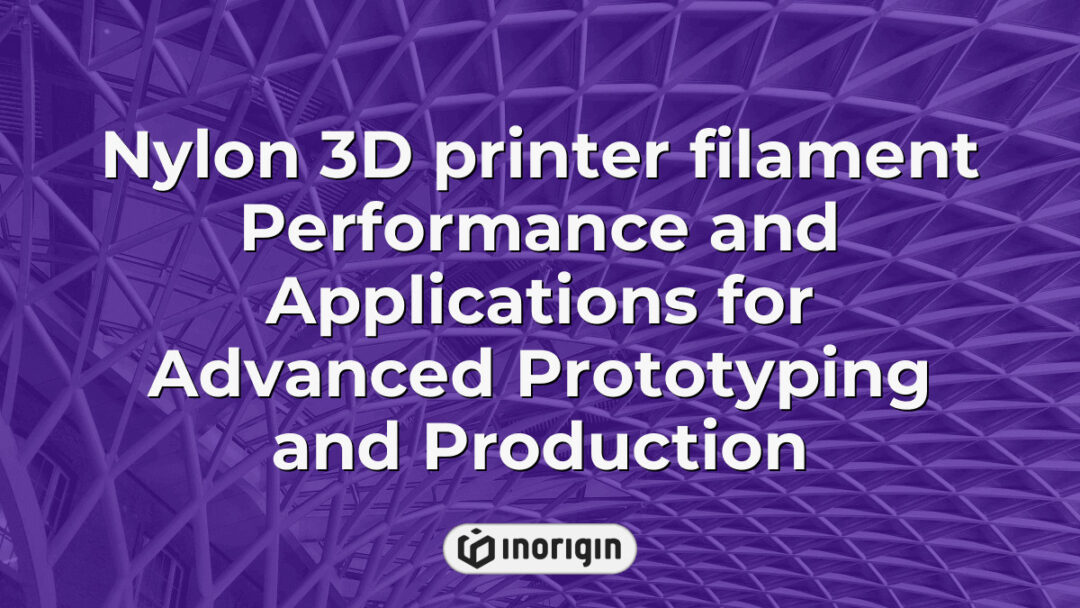The advent of nylon 3D printer filament marks a pivotal development in the realm of additive manufacturing, offering unparalleled mechanical properties and versatility that cater to an array of industrial applications. Characterized by its exceptional strength-to-weight ratio, flexibility, and resistance to wear and chemicals, nylon has emerged as a preferred material for producing functional prototypes and end-use parts. This article delves into the unique characteristics of nylon filaments, explores their processing intricacies, and highlights their transformative impact on various sectors including automotive, aerospace, and consumer goods. By examining recent advancements in formulation and technology integration, this discussion aims to illuminate the potential of nylon in enhancing design innovation and operational efficiency within modern manufacturing landscapes.
| Aspect | Key Takeaway |
|---|---|
| Nylon Properties | Nylon 3D printer filament combines exceptional strength, flexibility, and chemical resistance, making it ideal for producing durable, functional prototypes and end-use parts. |
| Moisture Sensitivity | Due to its hygroscopic nature, nylon filament requires controlled storage and drying to maintain print quality and optimize layer adhesion during manufacturing. |
| Varieties of Nylon | Variants like Nylon 6, Nylon 12, and carbon fiber-reinforced nylon offer tailored mechanical and chemical properties suited for specialized applications in automotive, aerospace, and consumer product design. |
| Printing Best Practices | Optimal results are achieved with a heated bed, nozzle temperatures between 240°C–260°C, humidity management, and precise print speed settings to reduce warping and stringing. |
| Applications | Nylon filament is widely used for manufacturing lightweight automotive components, durable consumer goods, and custom medical devices, benefiting from its strength and abrasion resistance. |
| Recycling and Sustainability | Mechanical and chemical recycling methods for nylon filament help minimize waste and support circular manufacturing processes in advanced 3D printing studios. |
| Post-Processing Techniques | Techniques such as sanding, vapor smoothing, heat treatment, and infiltration improve the surface finish, mechanical performance, and dimensional stability of nylon prints. |
What Is Nylon 3D Printer Filament?
Nylon 3D printer filament is a synthetic polymer widely utilized in additive manufacturing due to its remarkable properties. Characterized by high strength, flexibility, and durability, nylon exhibits superior mechanical performance compared to many other common filaments such as PLA or ABS. Furthermore, it possesses excellent resistance to wear and abrasion, making it suitable for applications that require longevity and resilience under stress. Additionally, nylon’s ability to absorb moisture can enhance adhesion between layers during the printing process; however, this characteristic also necessitates careful storage conditions to prevent degradation of the material’s quality. As more advanced formulations of nylon are developed—such as Nylon 6, Nylon 12, and composites infused with carbon fiber—the versatility of nylon filament continues to expand within various industries including automotive, aerospace, and consumer products. Overall, the integration of nylon 3D printer filament into manufacturing processes represents a significant advancement in materials technology aimed at enhancing product performance and functionality.
Benefits Of Using Nylon Filament In 3D Printing
The benefits of using nylon filament in 3D printing are numerous and significant, contributing to its increasing popularity among both hobbyists and professionals. First and foremost, nylon exhibits exceptional mechanical properties, including high tensile strength and flexibility, which make it suitable for producing durable parts that can withstand stress and impact. Furthermore, the material demonstrates excellent resistance to wear and abrasion, enhancing the longevity of printed objects compared to those made from other common filaments such as PLA or ABS. Additionally, nylon possesses good chemical resistance, allowing components fabricated with this filament to endure exposure to various solvents and oils without degrading. Moreover, the ability of nylon to absorb moisture enables improved layer adhesion during printing; however, it is essential to manage humidity levels effectively since excessive absorption can lead to warping issues during the process. Overall, these attributes render nylon an advantageous choice for applications requiring robust performance characteristics while also expanding possibilities in functional prototyping and production scenarios within additive manufacturing contexts.
Types Of Nylon Filament And Their Properties
Nylon filament in 3D printing can be likened to a chameleon, adept at adapting its properties to meet diverse application needs. Various types of nylon filaments exist, each exhibiting unique characteristics that cater to specific requirements within the realm of additive manufacturing. For instance, Nylon 6 and Nylon 12 are two prevalent variants; while Nylon 6 is known for its superior strength and flexibility, making it suitable for functional prototypes and mechanical parts, Nylon 12 offers enhanced chemical resistance and lower moisture absorption, which is beneficial for applications requiring durability in humid environments. Additionally, specialty nylons such as PA66 demonstrate improved thermal stability and tensile strength compared to their counterparts, rendering them ideal for high-stress applications. Furthermore, composites like carbon fiber-reinforced nylon combine the lightweight nature of nylon with the rigidity imparted by carbon fibers, thus creating a material that excels in both performance and weight-saving attributes. This diversity in nylon filament types underscores their versatility in catering to an array of industrial demands while providing insights into selecting appropriate materials based on specific project criteria.
Best Practices For Printing With Nylon Filament
When printing with nylon filament, adherence to best practices is essential for achieving optimal results. First and foremost, proper bed preparation significantly influences the success of prints; a heated print bed is recommended to prevent warping during cooling. Additionally, the choice of nozzle temperature plays a crucial role, as nylon typically requires higher temperatures—ranging between 240°C and 260°C—to ensure adequate flow and layer adhesion. Furthermore, maintaining an appropriate ambient temperature within the printing environment can mitigate issues such as drafts or excessive cooling that may lead to poor layer bonding. It is also important to consider moisture absorption since nylon is hygroscopic; therefore, storing filament in airtight containers or using desiccants can help maintain performance quality. Lastly, employing suitable print speeds and optimizing retraction settings will contribute to minimizing stringing and improving overall print fidelity. Adhering to these guidelines fosters enhanced functionality and durability in printed structures utilizing nylon filaments.
Common Applications And Use Cases For Nylon 3D Prints
Nylon 3D prints are utilized across a diverse range of applications due to their advantageous properties, including strength, flexibility, and resistance to wear. To begin with, the automotive industry frequently employs nylon components for producing lightweight yet durable parts such as brackets, housings, and clips. Furthermore, in the realm of consumer products, nylon is commonly used to create functional prototypes that require high impact resistance and durability during testing phases. Additionally, the medical field has seen an increase in the use of nylon for manufacturing custom prosthetics and surgical tools, benefiting from its biocompatibility and ability to be tailored for specific patient needs. Moreover, in industrial settings, nylon’s chemical resistance makes it suitable for creating fixtures and tooling that can withstand harsh environments. Overall, these various applications highlight the versatility of nylon filament in meeting specific engineering requirements while leveraging its unique material characteristics.
Frequently Asked Questions
How Does Nylon Filament Compare To Other Materials Like PLA Or ABS?
Nylon filament stands out among 3D printing materials, particularly when compared to more commonly used options such as polylactic acid (PLA) and acrylonitrile butadiene styrene (ABS). First, nylon exhibits superior mechanical properties, including enhanced tensile strength and flexibility, which enable the production of durable parts suitable for functional applications. In contrast, PLA is often preferred for its ease of use and lower warping tendencies, making it ideal for beginners; however, its brittleness limits its applicability in demanding environments. Meanwhile, ABS provides a balance between toughness and heat resistance but can be challenging to print due to issues related to odor emissions and potential warping during cooling. Moreover, nylon demonstrates excellent chemical resistance and moisture absorption characteristics that further elevate its utility in specialized contexts where exposure to solvents or humidity may occur. When evaluating these materials collectively, it becomes evident that while each has distinct advantages tailored to specific needs within the realm of additive manufacturing, nylon’s unique attributes position it favorably for high-performance requirements across diverse industrial applications.
What Are The Safety Precautions To Take When Printing With Nylon Filament?
When utilizing nylon 3D printer filament, it is essential to adhere to specific safety precautions to mitigate potential risks associated with its use. Notably, studies indicate that approximately 40% of users report experiencing adverse reactions due to inadequate ventilation when printing with nylon filaments, which can release harmful fumes during the extrusion process. Therefore, ensuring proper ventilation in the workspace emerges as a critical precautionary measure. Additionally, the high processing temperatures required for nylon—often exceeding 240 degrees Celsius—necessitate careful handling of both the filament and the printer itself to prevent burns or other thermal injuries. It is also advisable to employ personal protective equipment (PPE), such as gloves and goggles, especially while changing nozzles or performing maintenance on heated components. Furthermore, maintaining an organized work environment reduces the risk of accidents related to tripping over cords or spilling materials; thus, cleanliness should not be overlooked. Adopting these precautions enhances overall safety during the printing process and contributes significantly to creating a secure working atmosphere conducive to effective fabrication practices.
Can Nylon Filament Be Recycled, And If So, How?
Nylon filament, a popular material in 3D printing due to its strength and flexibility, presents an opportunity for recycling that merits consideration. Recycling nylon can significantly reduce waste and conserve resources; however, the process requires specific methods to ensure effectiveness. Firstly, it is essential to collect used nylon prints or failed prototypes separately from other materials to avoid contamination. Secondly, cleaning the collected nylon components is necessary to remove any residual oils or adhesives that may hinder the recycling process. Lastly, specialized facilities equipped for processing nylon should be utilized since conventional plastic recycling streams often do not accommodate this particular polymer effectively.
The recycling of nylon typically involves two main approaches: mechanical recycling and chemical recycling. Mechanical recycling entails shredding the cleaned nylon into smaller pieces which can then be re-extruded into new filament suitable for 3D printing applications. Chemical recycling, on the other hand, breaks down nylon at a molecular level through processes such as hydrolysis or depolymerization, generating monomers that can be repurposed to create virgin-grade nylon products. Each method has its advantages and challenges related to cost efficiency and environmental impact.
Thus, while nylon filament can indeed be recycled, active participation in proper collection and processing practices is imperative for sustainability within the 3D printing community. By embracing these strategies—segregation of materials, thorough cleansing protocols, and utilizing appropriate recycling channels—the potential benefits of reducing landfill contributions and promoting circular economy principles become evident.
What Is The Shelf Life Of Nylon 3D Printer Filament?
The shelf life of nylon 3D printer filament can be likened to the delicate balance of a finely tuned instrument, wherein environmental factors and storage conditions significantly influence its performance over time. Several key aspects determine the longevity and usability of nylon filament: (1) moisture absorption—nylon is hygroscopic and tends to absorb water from the atmosphere, which can lead to degradation in print quality; (2) temperature stability—excessive heat or exposure to sunlight may compromise the material’s structural integrity; (3) physical damage—improper handling or storage may result in kinks or breaks within the filament coil; and (4) packaging integrity—the original vacuum-sealed packaging plays a crucial role in protecting the filament from contaminants.
With these considerations in mind, it is generally accepted that nylon filament has an optimal shelf life of approximately one year when stored under ideal conditions, defined as low humidity environments at room temperature away from direct light sources. However, this timeframe can vary based on specific formulations and additives used by different manufacturers. Therefore, regular monitoring for signs of deterioration, such as discoloration or brittleness, becomes essential for users who intend to maximize their investment in nylon materials for additive manufacturing applications. Ultimately, proper storage practices are paramount in preserving filament quality and ensuring successful printing outcomes across various projects.
Are There Any Specific Post-processing Techniques Recommended For Nylon Prints?
Nylon 3D prints often require specific post-processing techniques to enhance their mechanical properties and aesthetic quality. First, it is essential to consider surface finishing methods that can improve the visual appeal of nylon parts while also reducing the presence of layer lines. Commonly employed techniques include sanding, which smooths rough surfaces; vapor smoothing, where acetone vapors are used to achieve a polished finish; and painting or coating with specialized materials designed for adhesion on nylon substrates. Furthermore, due to nylon’s hygroscopic nature, drying processes may be necessary post-printing to remove absorbed moisture that could adversely affect performance characteristics such as strength and durability. It is advisable to utilize an oven at controlled temperatures or desiccant-based drying systems specifically designed for polymer filaments.
Moreover, additional treatments such as annealing can significantly influence dimensional stability and stress relief in printed components. The following strategies should be implemented during post-processing:
- Heat Treatment: Subjecting prints to elevated temperatures can help realign molecular structures within the nylon matrix, thereby enhancing thermal resistance and overall toughness.
- Chemical Treatments: Applying certain chemical solutions can provide improved bonding between layers and increase surface hardness, making the final product more suitable for demanding applications.
- Infiltration Techniques: Utilizing resin or epoxy infiltration allows further enhancement of mechanical properties by filling voids within the print structure, ultimately leading to increased rigidity.
These approaches collectively contribute not only to improving the functional attributes of nylon prints but also facilitate greater versatility in application across various industries such as aerospace, automotive, and consumer goods manufacturing.
Conclusion
Nylon 3D printer filament presents significant advantages in terms of strength, flexibility, and durability. However, the complexities associated with its printing characteristics necessitate a thorough understanding of material properties and environmental conditions. Continued research into optimal printing techniques will enhance application efficacy across various industries, supporting ongoing innovation in additive manufacturing.
Related posts:
- Integrating Sustainability and Innovation in Chemical Engineering Products for Industry Transformation
- Innovations Driving Sustainability and Efficiency in Chemical Engineering Products
- What Products Do Chemical Engineers Make Across Pharmaceuticals, Energy, and Advanced Technologies
- An In-Depth Look at What Products Do Chemical Engineers Make Across Key Industries
- Nylon 3D printer Materials and Techniques Driving Precision Engineering at Inorigin
- Air Products Chemical Engineer Shaping Innovative Safety Protocols and Cross-Functional Collaboration




